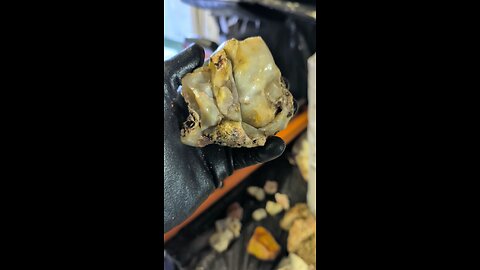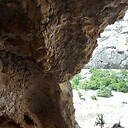
Onyx!
1 video
Updated 7 months ago
Onyx is a variety of chalcedony, which is a cryptocrystalline form of quartz. Here's an in-depth look at onyx:
Formation:
Geological Origin: Onyx forms in the gas cavities of lava, similar to agate, where silica-rich water percolates into the openings, depositing layers of chalcedony over time.
Mineral Composition: Predominantly silicon dioxide (SiO₂), with the color variations coming from impurities like iron, manganese, or carbon.
Characteristics:
Appearance:
Color: Traditionally, onyx is thought of as black, but true black onyx is quite rare. Most "black onyx" is actually dyed chalcedony. Natural onyx can show bands in various colors like white, brown, or even red.
Bands: Onyx is known for its parallel banding, which is usually straight or slightly curved, unlike the more concentric bands of agate.
Hardness: Onyx has a Mohs hardness of about 6.5 to 7, making it relatively hard and suitable for jewelry.
Types:
Black Onyx: Often dyed to enhance or achieve the black color.
Sardonyx: A type of onyx with reddish-brown bands (sard) alternating with white or black bands.
Carnelian Onyx: Features the red or orange of carnelian with white or black bands.
Uses:
Jewelry:
Cabochons: Onyx is commonly cut into cabochons for rings, bracelets, and pendants.
Beads: Used in necklaces and bracelets for its striking appearance and durability.
Cameos: Onyx, particularly sardonyx, has been historically used for carving cameos due to its banded nature allowing for contrast in relief carvings.
Decorative Objects: Small sculptures, inlays, and decorative items benefit from onyx's aesthetic qualities.
Cultural Significance:
In many cultures, onyx is associated with protection, grounding, and strength. It's often used in talismans or amulets.
Care:
Cleaning: Onyx should be cleaned with mild soap and water, avoiding harsh chemicals that could damage the stone or its dye.
Avoid: Ultrasonic cleaners and steam cleaning are generally not recommended for onyx, especially if dyed.
Considerations:
Durability: While onyx is durable, its hardness is less than some other gemstones like sapphire or diamond, so care should be taken to avoid rough wear.
Dyeing: Much of the onyx available is dyed, and this should be considered in terms of care and longevity of color.
Onyx's elegant and versatile appearance makes it a popular choice in jewelry and decorative arts, but understanding its natural versus dyed forms is crucial for both its use and maintenance.
-
Agate Cut!
 HumbleConservativeBased on the appearance of the rock in the image, it looks like it could be a type of chalcedony, specifically an agate. Agates are known for their banded or layered appearance, often with translucent to semi-translucent qualities. The rock in the image shows a mix of colors and a somewhat banded structure, which is characteristic of agates. They commonly form in volcanic and sedimentary rocks and are often found in cavities or veins.46 views
HumbleConservativeBased on the appearance of the rock in the image, it looks like it could be a type of chalcedony, specifically an agate. Agates are known for their banded or layered appearance, often with translucent to semi-translucent qualities. The rock in the image shows a mix of colors and a somewhat banded structure, which is characteristic of agates. They commonly form in volcanic and sedimentary rocks and are often found in cavities or veins.46 views